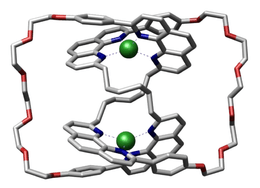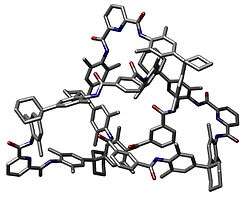Molecular knot
In chemistry, a molecular knot is a mechanically-interlocked molecular architecture that is analogous to a macroscopic knot.[1] Naturally forming molecular knots are found in organic molecules like DNA, RNA, and proteins. It is not certain that naturally-occurring knots are evolutionarily advantageous to nucleic acids or proteins, though knotting is thought to play a role in the structure, stability, and function of knotted biological molecules.[2] The mechanism by which knots naturally form in molecules, and the mechanism by which a molecule is stabilized or improved by knotting, is ambiguous.[3] The study of molecular knots involves the formation and applications of both naturally-occurring and chemically synthesized molecular knots. Applying chemical topology and knot theory to molecular knots allows biologists to better understand the structures and synthesis of knotted organic molecules[1].
The term knotane was coined by Vögtle et al. in 2000 to describe molecular knots by analogy with rotaxanes and catenanes, which are other mechanically interlocked molecular architectures.[1][4] The term has not been broadly adopted by chemists and has not been adopted by IUPAC.


Naturally-Occurring Molecular Knots
Organic molecules containing knots may fall into the categories of slipknots or pseudo-knots.[2] They are not considered mathematical knots because they are not a closed curve, but rather a knot that exists within an otherwise linear chain, with termini at each end. Knotted proteins are thought to form molecular knots during their tertiary structure folding process, and knotted nucleic acids generally form molecular knots during genomic replication and transcription,[6] though details of knotting mechanism continue to be disputed and ambiguous. Molecular simulations are fundamental to the research on molecular knotting mechanisms.
Knotted DNA was found first by Liu et. al in 1981, in single-stranded, circular, bacterial DNA, though double-stranded circular DNA has been found to also form knots. Naturally-knotted RNA has not yet been reported.[7]
A number of proteins containing naturally-occurring molecular knots have been identified. The knot types found to be naturally-occurring in proteins are the and knots, as identified in the KnotProt database of known knotted proteins.[8]
Chemically Synthesized Molecular Knots
Several synthetic molecular knots have been reported.[9][10][11][12][13][14] Knot types that have been successfully synthesized in molecules are and 819 knots. Though the and knots have been found to naturally occur in knotted molecules, they have not been successfully synthesized. Small-molecule composite knots have also not yet been synthesized.[7]
Artificial DNA, RNA, and protein knots have been successfully synthesized. DNA is a particularly useful model of synthetic knot synthesis, as the structure naturally forms interlocked structures and can be easily manipulated into forming knots[15] control precisely the raveling necessary to form knots.Molecular knots are often synthesized with the help of crucial metal ion ligands.[7]
History
The first researcher to suggest the existence of a molecular knot in a protein was Jane Richardson in 1977, who reported that carbonic anhydrase B (CAB) exhibited apparent knotting during her survey of various proteins' topological behavior.[16] However, the researcher generally attributed with the discovery of the first knotted protein is Marc. L. Mansfield in 1994, as he was the first to specifically investigate the occurrence of knots in proteins and confirm the existence of the trefoil knot in CAB. Knotted DNA was found first by Liu et. al in 1981, in single-stranded, circular, bacterial DNA, though double-stranded circular DNA has been found to also form knots.[17]
In 1989, Sauvage and coworkers reported the first synthetic knotted molecule: a trefoil synethesized via a double-helix complex with the aid of Cu+ ions.[18]
Vogtle et. al. was the first to describe molecular knots as knotanes in 2000.[1] Also in 2000 was William Taylor's creation of an alternative computational method to analyze protein knotting that set the termini at a fixed point far enough away from the knotted component of the molecule that the knot type could be well-defined. In this study, Taylor discovered a deep knot in a protein.[19] With this study, Taylor confirmed the existence of deeply knotted proteins.
In 2007, Eric Yeates reported the identification of a molecular slipknot, which is when the molecule contains knotted subchains even though their backbone chain as a whole is unknotted and does not contain completely knotted structures that are easily detectable by computational models.[20] Mathematically, slipknots are difficult to analyze because they are not recognized in the examination of the complete structure.
A pentafoil knot prepared using dynamic covalent chemistry was synthesized by Ayme et. al in 2012, which at the time was the most complex non-DNA molecular knot prepared to date.[21] Later in 2016, a fully organic pentafoil knot was also reported, including the very first use of a molecular knot to allosterically regulate catalysis.[22] In January 2017, an 819 knot was synthesized by David Leigh's group, making the 819 knot the most complex molecular knot synthesized.[23]
Applications
Many synthetic molecular knots have a distinct globular shape and dimensions that make them potential building blocks in nanotechnology.
See also
- Circuit topology of folded linear molecules
- Supramolecular chemistry
- Knotted protein
- Knotted polymers
- Topology (chemistry)
- Knot theory
References
- Lukin, Oleg; Vögtle, Fritz (25 February 2005). "Knotting and Threading of Molecules: Chemistry and Chirality of Molecular Knots and Their Assemblies". Angewandte Chemie International Edition. 44 (10): 1456–1477. doi:10.1002/anie.200460312. PMID 15704147.
- Lim, Nicole C. H.; Jackson, Sophie E. (20 August 2015). "Molecular knots in biology and chemistry". Journal of Physics: Condensed Matter. 27 (35): 354101. Bibcode:2015JPCM...27I4101L. doi:10.1088/0953-8984/27/35/354101. ISSN 0953-8984. PMID 26291690.
- Xu, Yan; Li, Shixin; Yan, Zengshuai; Luo, Zhen; Ren, Hao; Ge, Baosheng; Huang, Fang; Yue, Tongtao (2018-11-06). "Stabilizing Effect of Inherent Knots on Proteins Revealed by Molecular Dynamics Simulations". Biophysical Journal. 115 (9): 1681–1689. Bibcode:2018BpJ...115.1681X. doi:10.1016/j.bpj.2018.09.015. ISSN 0006-3495. PMC 6225051. PMID 30314655.
- Safarowsky O, Nieger M, Fröhlich R, Vögtle F (2000). "A Molecular Knot with Twelve Amide Groups - One-Step Synthesis, Crystal Structure, Chirality". Angewandte Chemie International Edition. 39 (9): 1616–1618. doi:10.1002/(SICI)1521-3773(20000502)39:9<1616::AID-ANIE1616>3.0.CO;2-Y. PMID 10820452.
- Albrecht-Gary, A. M.; Meyer, M.; Dietrich-Buchecker, C. O.; Sauvage, J. P.; Guilhem, J.; Pascard, C. (2 September 2010). "Dicopper (I) trefoil knots: Demetallation kinetic studies and molecular structures". Recueil des Travaux Chimiques des Pays-Bas. 112 (6): 427–428. doi:10.1002/recl.19931120622.
- Qi, Xiaodong; Zhang, Fei; Su, Zhaoming; Jiang, Shuoxing; Han, Dongran; Ding, Baoquan; Liu, Yan; Chiu, Wah; Yin, Peng; Yan, Hao (2018-11-02). "Programming molecular topologies from single-stranded nucleic acids". Nature Communications. 9 (1): 4579. Bibcode:2018NatCo...9.4579Q. doi:10.1038/s41467-018-07039-7. ISSN 2041-1723. PMC 6214983. PMID 30389935.
- Fielden, Stephen D. P.; Leigh, David A.; Woltering, Steffen L. (2017-09-04). "Molecular Knots". Angewandte Chemie International Edition. 56 (37): 11166–11194. doi:10.1002/anie.201702531. ISSN 1433-7851. PMC 5582600. PMID 28477423.
- Jamroz, Michal; Niemyska, Wanda; Rawdon, Eric J.; Stasiak, Andrzej; Millett, Kenneth C.; Sułkowski, Piotr; Sulkowska, Joanna I. (2015-01-28). "KnotProt: a database of proteins with knots and slipknots". Nucleic Acids Research. 43 (Database issue): D306–D314. doi:10.1093/nar/gku1059. ISSN 0305-1048. PMC 4383900. PMID 25361973.
- Ashton, Peter R.; Matthews, Owen A.; Menzer, Stephan; Raymo, Françisco M.; Spencer, Neil; Stoddart, J. Fraser; Williams, David J. (December 1997). "Molecular Meccano, 27. A Template-directed Synthesis of a Molecular Trefoil Knot". Liebigs Annalen. 1997 (12): 2485–2494. doi:10.1002/jlac.199719971210.
- Rapenne, Gwénaël; Dietrich-Buchecker, and Jean-Pierre Sauvage *, Christiane; Sauvage, Jean-Pierre (February 1999). "Copper(I)- or Iron(II)-Templated Synthesis of Molecular Knots Containing Two Tetrahedral or Octahedral Coordination Sites". Journal of the American Chemical Society. 121 (5): 1002–1015. doi:10.1021/ja982239+.
- Feigel, Martin; Ladberg, Rüdiger; Engels, Simon; Herbst-Irmer, Regine; Fröhlich, Roland (25 August 2006). "A Trefoil Knot Made of Amino Acids and Steroids". Angewandte Chemie International Edition. 45 (34): 5698–5702. doi:10.1002/anie.200601111. PMID 16856201.
- Guo, Jun; Mayers, Paul C.; Breault, Gloria A.; Hunter, Christopher A. (7 February 2010). "Synthesis of a molecular trefoil knot by folding and closing on an octahedral coordination template". Nature Chemistry. 2 (3): 218–222. Bibcode:2010NatCh...2..218G. doi:10.1038/nchem.544. PMID 21124480.
- Barran, Perdita E.; Cole, Harriet L.; Goldup, Stephen M.; Leigh, David A.; McGonigal, Paul R.; Symes, Mark D.; Wu, Jhenyi; Zengerle, Michael (16 December 2011). "Active-Metal Template Synthesis of a Molecular Trefoil Knot". Angewandte Chemie International Edition. 50 (51): 12280–12284. doi:10.1002/anie.201105012. PMID 21919173.
- Carina, Riccardo F.; Dietrich-Buchecker, Christiane; Sauvage, Jean-Pierre (January 1996). "Molecular Composite Knots". Journal of the American Chemical Society. 118 (38): 9110–9116. doi:10.1021/ja961459p.
- Sauvage, Jean-Pierre; Amabilino, David B. (2012), "Templated Synthesis of Knots and Ravels", Supramolecular Chemistry, American Cancer Society, doi:10.1002/9780470661345.smc085, ISBN 978-0-470-66134-5
- Richardson, Jane S. (August 1977). "β-Sheet topology and the relatedness of proteins". Nature. 268 (5620): 495–500. Bibcode:1977Natur.268..495R. doi:10.1038/268495a0. ISSN 1476-4687. PMID 329147.
- Liu, L F; Davis, J L; Calendar, R (1981-08-25). "Novel topologically knotted DNA from bacteriophage P4 capsids: studies with DNA topoisomerases". Nucleic Acids Research. 9 (16): 3979–3989. doi:10.1093/nar/9.16.3979. ISSN 0305-1048. PMC 327409. PMID 6272191.
- Dietrich‐Buchecker, Christiane O.; Sauvage, Jean-Pierre (1989). "A Synthetic Molecular Trefoil Knot". Angewandte Chemie International Edition in English. 28 (2): 189–192. doi:10.1002/anie.198901891. ISSN 1521-3773.
- Faísca, Patrícia F. N. (2015-01-01). "Knotted proteins: A tangled tale of Structural Biology". Computational and Structural Biotechnology Journal. 13: 459–468. doi:10.1016/j.csbj.2015.08.003. ISSN 2001-0370. PMC 4556803. PMID 26380658.
- King, Neil P.; Yeates, Eric O.; Yeates, Todd O. (2007-10-12). "Identification of Rare Slipknots in Proteins and Their Implications for Stability and Folding". Journal of Molecular Biology. 373 (1): 153–166. doi:10.1016/j.jmb.2007.07.042. ISSN 0022-2836. PMID 17764691.
- Ayme, Jean-François; Beves, Jonathon E.; Leigh, David A.; McBurney, Roy T.; Rissanen, Kari; Schultz, David (6 November 2011). "A synthetic molecular pentafoil knot". Nature Chemistry. 4 (1): 15–20. Bibcode:2012NatCh...4...15A. doi:10.1038/nchem.1193. PMID 22169866.
- Marcos, Vanesa; Stephens, Alexander J.; Jaramillo-Garcia, Javier; Nussbaumer, Alina L.; Woltering, Steffen L.; Valero, Alberto; Lemonnier, Jean-François; Vitorica-Yrezabal, Iñigo J.; Leigh, David A. (2016-06-24). "Allosteric initiation and regulation of catalysis with a molecular knot". Science. 352 (6293): 1555–1559. Bibcode:2016Sci...352.1555M. doi:10.1126/science.aaf3673. ISSN 0036-8075. PMID 27339983.
- Danon, Jonathan J.; Krüger, Anneke; Leigh, David A.; Lemonnier, Jean-François; Stephens, Alexander J.; Vitorica-Yrezabal, Iñigo J.; Woltering, Steffen L. (2017-01-13). "Braiding a molecular knot with eight crossings". Science. 355 (6321): 159–162. Bibcode:2017Sci...355..159D. doi:10.1126/science.aal1619. ISSN 0036-8075. PMID 28082585.